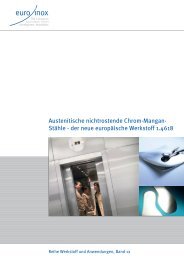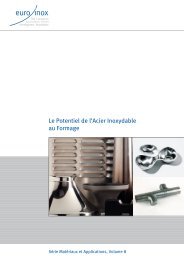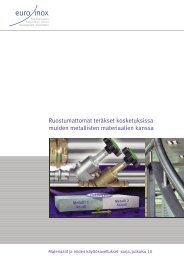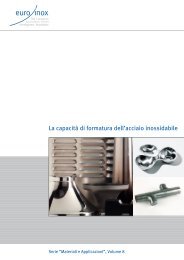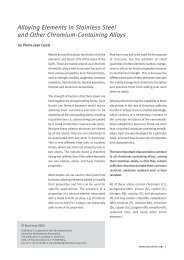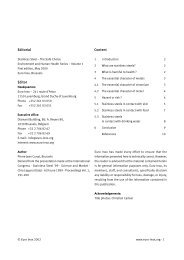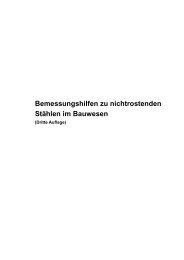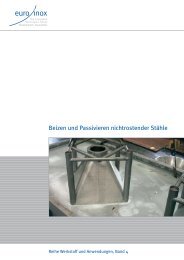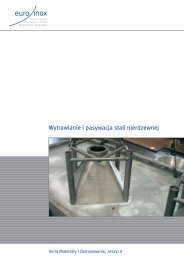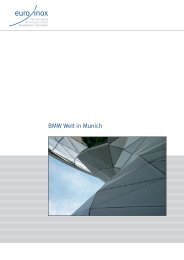The Ferritic Solution - Euro Inox
The Ferritic Solution - Euro Inox
The Ferritic Solution - Euro Inox
Create successful ePaper yourself
Turn your PDF publications into a flip-book with our unique Google optimized e-Paper software.
mechanical and physical properties<br />
<strong>Ferritic</strong> stainless steel grades are fabrication-friendly and suitable for a very<br />
wide range of applications.<br />
ferritics have good mechanical properties, occupying an<br />
intermediate position in this respect when compared to<br />
the other stainless steel families. they have higher yield<br />
strength than austenitics, while their elongation and forming<br />
properties are equivalent to those of carbon steels. their<br />
physical properties include two characteristics in which<br />
they out-perform austenitic grades: thermal expansion and<br />
thermal conductivity.<br />
MechanicaL pRopeRtieS<br />
generally speaking, the mechanical properties of a<br />
metallic alloy are those that describe the material’s ability<br />
to compress, stretch, bend, scratch, dent or break. the<br />
most commonly used criteria for evaluating mechanical<br />
characteristics are:<br />
• Strength: the degree of resistance of a material to<br />
deformation. two critical values are generally considered:<br />
• yield strength, or the stress the material can be<br />
subjected to before permanent plastic deformation<br />
occurs;<br />
• tensile strength, or the stress it can be subjected to<br />
before rupture/failure.<br />
• hardness: the degree of resistance to indentation by an<br />
applied load.<br />
• toughness: the capacity to absorb deformation energy<br />
before fracture.<br />
• ductility (or plasticity): the ability to deform plastically<br />
without fracturing.<br />
Some of these properties can be measured by a tensile<br />
test. the resulting stress-strain curves make it possible to<br />
determine yield strength (yS), ultimate tensile strength (utS)<br />
and total elongation at failure (e). these tests result in the<br />
definition of a stress-strain curve charting the performance<br />
of the metal in response to various loads.<br />
STRESS (MPa)<br />
UTS<br />
600<br />
UTS<br />
500<br />
400<br />
YS<br />
300<br />
YS<br />
200<br />
100<br />
0<br />
utS is measured in Mpa (1Mpa = 1n/mm 3 = 145pSi = 0.1kg/mm 3 ) and represents<br />
maximum resistance at failure. yS refers to the beginning of the “plastic” phase, where<br />
elongation no longer disappears when the stress is removed.<br />
the stress-strain curves show that while ferritic grade 430<br />
has its limits, it clearly performs exceptionally well within<br />
those limits.<br />
MARTENSITIC<br />
STAINLESS STEELS<br />
HSLA STEELS<br />
A36<br />
CARBON STEELS<br />
FERRITICS<br />
STAINLESS STEELS<br />
TYPE 430<br />
FERRITIC STAINLESS:<br />
EQUIVALENT TO<br />
CARBON STEEL<br />
AUSTENITICS<br />
STAINLESS STEELS<br />
TYPE 304/316<br />
AUSTENITICS:<br />
EASIER TO FORM<br />
INTO COMPLEX SHAPES<br />
4 8 12 16 20 24 28 32 36 40 44 48 EI<br />
STRAIN<br />
“…ferritics and austenitics can<br />
be seen as two interchangeable<br />
stainless steel families.”<br />
Bus body frame, in grade 410, S. Africa.<br />
STRESS (Ksi)<br />
Escalator steps, in grade SUS430, Japan.



